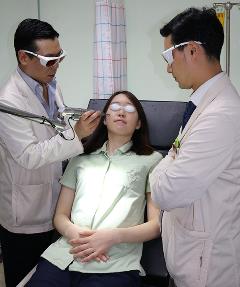Using a picosecond laser with dual‐wavelength can reduce the photothermal effect generated during the removal of pigment and total duration of the procedure, and can be expected to reduce the occurrence of adverse events.
 Wausau, WI (December 25, 2017) – Melasma is a common acquired, chronic hypermelanosis and still remains a therapeutic challenge. The low-fluence 1064-nm Q-switched Nd:YAG laser is the most widely used for the treatment of moderate to severe melasma in Asia. Recently, the picosecond laser has been introduced for various pigmentary disorders such as melasma. In a recent study published in Lasers in Surgery and Medicine (LSM), the official journal of the American Society for Laser Medicine and Surgery, Inc. (ASLMS), the efficacy and safety of a picosecond laser with dual-wavelengths (1064-nm and 595-nm) and topical 2% hydroquinone (HQ) combination therapy was evaluated on patients with melasma, and results were compared with those obtained with 2% HQ alone.
Wausau, WI (December 25, 2017) – Melasma is a common acquired, chronic hypermelanosis and still remains a therapeutic challenge. The low-fluence 1064-nm Q-switched Nd:YAG laser is the most widely used for the treatment of moderate to severe melasma in Asia. Recently, the picosecond laser has been introduced for various pigmentary disorders such as melasma. In a recent study published in Lasers in Surgery and Medicine (LSM), the official journal of the American Society for Laser Medicine and Surgery, Inc. (ASLMS), the efficacy and safety of a picosecond laser with dual-wavelengths (1064-nm and 595-nm) and topical 2% hydroquinone (HQ) combination therapy was evaluated on patients with melasma, and results were compared with those obtained with 2% HQ alone.
The research was conducted by Young-Jun Choi, MD; Jae-Hui Nam, MD; Jung Yup Kim, MD; Joon Hong Min, MD; Kui Young Park, MD, PhD; Eun Jung Ko, MD; Beom Joon Kim, MD, PhD; and Won-Serk Kim, MD, PhD. Their manuscript titled, “Efficacy and Safety of a Novel Picosecond Laser Using Combination of 1064-nm and 595-nm on Patients With Melasma: A Prospective, Randomized, Multicenter, Splitface, 2% Hydroquinone Cream-controlled Clinical Trial” was selected as Editor’s Choice in the December 2017 issue of LSM.
The study confirmed that 750 picosecond laser using 1064-nm and 595-nm was effective and safe for the treatment of Korean melasma patients. The picosecond laser with dual-wavelength used in the study can reduce the photothermal effect generated during the removal of pigment and total duration of the procedure, and can be expected to reduce the occurrence of adverse events.
“Efficacy and safety of the laser device were verified by demonstrating superiority of the 1064-nm and 595-nm picosecond laser, and 2% HQ cream combination therapy compared with the case of using 2% HQ cream alone in the treatment of Korean melasma patients. The picosecond laser with dual-wavelength used in this study can reduce the photothermal effect generated during the removal of pigment and total duration of the procedure, and can be expected to reduce the occurrence of adverse events. This device offers a new and potentially safe therapeutic modality for moderate to severe melasma in patients with skin of color,” said Dr. Choi.
Young-Jun Choi, MD is a Clinical Fellow in the Department of Dermatology, Kangbuk Samsung Hospital, Sungkyunkwan University School of Medicine, Seoul, Korea.
Editor’s Choice is an exclusive article published in LSM, the official journal of the ASLMS. View the complete manuscript.
The American Society for Laser Medicine and Surgery, Inc. (ASLMS) is the largest multi-disciplinary professional organization, dedicated to the development and application of lasers and related technology for health care applications. ASLMS promotes excellence in patient care by advancing biomedical application of lasers and other related technologies worldwide. Currently, ASLMS has over 4,000 members, including physicians and surgeons representing more than 51 specialties, physicists involved in product development, biomedical engineers, biologists, nurses, industry representatives and manufacturers. For more information, visit aslms.org.